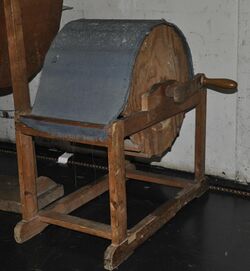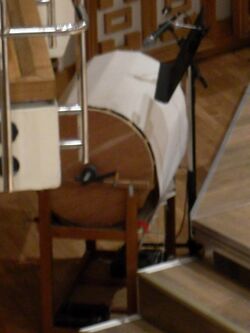Wind machine
File:1920's Stage Wind Machine.webm
The wind machine (also called an aeoliphone or aelophon) is a friction idiophone used to produce the sound of wind for orchestral compositions and musical theater productions.[1]
Construction
The wind machine is constructed of a large cylinder made up of several wooden slats which measures approximately 75–80 cm (30–31 in) in diameter. The cylinder body of the instrument rests upon a stand and is typically covered with silk, canvas, or other material which is in a fixed position. A crank handle, used by the player to rotate the cylinder and create the sound, is attached to the cylinder.[2]
Another method of construction implements an electric fan, which is fitted with lengths of cane, rather than blades. However, this method is less popular because it does not provide the player with the ability to control the speed of rotation.[3]
Technique
The wind machine is played by rotating the crank handle, which is attached to the cylinder, to create friction between the wooden slats and the material covering that touches the cylinder but does not rotate as the crank handle is turned. This friction between the wood and the material covering creates the sound of rushing wind. The volume and pitch of the sound is controlled by the rate at which the crank is turned. The faster the handle is turned, the higher the resulting pitch and the louder the sound. The slower the handle is turned, the lower the pitch and the softer the volume. The sound of the wind machine can also be controlled by the tightness of the fabric covering the cylinder.[1][4]
Classical works that use the instrument
- Jean-Philippe Rameau: Les Boréades
- Giacomo Puccini: La Fanciulla del West
- Gioachino Rossini: The Barber of Seville
- Richard Wagner: Der fliegende Holländer
- Richard Strauss: Don Quixote,[5] Eine Alpensinfonie (An Alpine Symphony), Josephslegende (1914), Die ägyptische Helena, and Die Frau ohne Schatten
- Edward Elgar: The Starlight Express
- Maurice Ravel: Daphnis et Chloé,[6][5] L'enfant et les sortilèges, Maurius Constant's orchestration of Gaspard de la nuit, iii. Scarbo
- Gottfried Huppertz: "Chronicles of the Gray House"
- Olivier Messiaen: Des canyons aux étoiles…,[6] Saint François d'Assise and Éclairs sur l'au-delà…
- Arnold Schoenberg: Die Jakobsleiter
- Benjamin Britten: Noye's Fludde
- Gyorgy Ligeti: Le Grand Macabre
- Ralph Vaughan Williams: Sinfonia antartica
- Ferde Grofé: Grand Canyon Suite
- Jerry Goldsmith: The Blue Max
- Fazıl Say: Symphony No 3 Universe
- Michael Tippett: Symphony No. 4
References
- ↑ Jump up to: 1.0 1.1 Adato, Joseph; Judy, George (1984). The Percussionist's Dictionary. Belwin-Mills. pp. 65. ISBN 978-0-91095-728-1. OCLC 12096511.
- ↑ Blades, James (2001). "Wind machine". in Holland, James. Oxford Music Online. Oxford University Press. doi:10.1093/gmo/9781561592630.article.30403. https://doi.org/10.1093/gmo/9781561592630.article.30403.
- ↑ Bond, Ryan (August 2022). "A Brief History of the Wind Machine". Percussive Notes 60 (4): 44–49.
- ↑ Blades, James (1992). Percussion Instruments and Their History (Rev. ed.). Bold Strummer. pp. 394–395. ISBN 978-0-933224-71-1. OCLC 28230162.
- ↑ Jump up to: 5.0 5.1 Jones, Barrie (2014). The Hutchinson Concise Dictionary of Music, p.731. Routledge. ISBN:9781135950187.
- ↑ Jump up to: 6.0 6.1 Chion, Michel (2016). Sound: An Acoulogical Treatise. Translated by James A. Steintrager. Duke University Press. doi:10.1215/9780822374824. ISBN 978-0-8223-7482-4. https://books.google.com/books?id=dZUpCwAAQBAJ.
External links
- Demonstration of a Wind Machine by Dame Evelyn Glennie
 |



